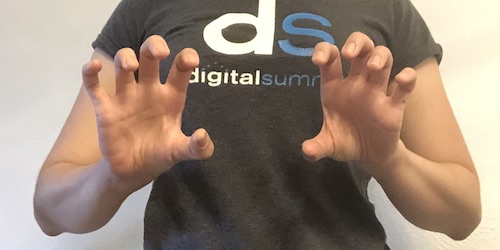Starting out as an improv beginner can be intimidating. I remember walking into my first improv open play and wondering if I’d be able to keep up…or make a total fool of myself. But the improvisers organizing the event knew great improv games that are welcoming for beginners just starting out. Whether you’re teaching an intro to improv class or just trying to include accessible games for everyone, these games are great for improvisers of all levels.
Here are ten of the best improv games for beginners:
- Yes, Let’s
- I Am a Tree
- 3-Line Scene (with “Yes, And”)
- The Ad Games
- Pass the Clap
- Alien, Tiger, Cow
- Group Counting
- One Word at a Time Story
- Fortunately, Unfortunately
- Three-Headed Expert
While low-pressure large group games and warmups are common go-tos for improv novices, it’s also important to think about the building blocks of becoming a better improviser. The following list includes beginner-friendly games and warmups that focus on several key improv skills: accepting and agreement, group mind, and storytelling.
Improv Games for Accepting and Agreement
Agreement is one of the fundamental tenets of improvisation and a crucial foundation for any scene. These group-focused improv games don’t keep the attention on any one person for too long, so they’re great for beginners. And, they also focus on listening to others and responding with clear and explicit agreement.
1. Yes, Let’s
How to play: Yes, let’s is a great improv warmup game since everyone can be involved, and the focus is never on one person alone. To start, everyone begins walking around the room, mingling without following any particular path. Then, someone yells out a suggestion for what the group should do, typically involving physical movement, such as “let’s hop like bunny rabbits” or “let’s go scuba diving.” Everyone else enthusiastically yells “yes, let’s!” and the group proceeds to do (or pretend to do) that action until a new person calls out a suggestion (e.g., “let’s bake chocolate chip cookies”).
Why it’s great: The enthusiastic agreement (yes, let’s!) is the key to this game. It brings up the energy level in the group and reaffirms one of the key tenets of improv: no matter how weird or unexpected a suggestion is, in an improv scene, you need to agree with the reality your scene partner has established.
This warmup game also gets people moving around the room and doing big physical movements, which can feel especially awkward for new improvisers (it definitely felt awkward for me at first). By engaging everyone in this movement at once, people are less likely to feel self-conscious.
2. I Am a Tree
How to play: In this game, three people create a scene-picture with their bodies. The first person proclaims that they are an object and positions their body to mimic that object. For example, they might stick out their arms like branches and say “I am a tree!” Then, anyone from the group can jump in and become an object that goes with the first object. For example, person B could say “I am a squirrel in the tree” and crouch down like a squirrel, or they could say “I am a pile of fallen leaves,” etc. A third person then jumps up and completes the scene (“I am a rake”). Once the three-person scene picture is complete, the third person remains onstage as the same object, and two more people jump in to create a completely different set of related objects.

Why it’s great: This game requires improvisers to agree with their scene partners by choosing objects that go with/fit the already established scene. There’s no pressure to say any dialogue, so it can be easier for newer improvisers to jump up and put themselves out there.
3. Three-Line Scene (with “Yes, And”)
How to play: Three-line scene is a classic improv exercise for a reason, and playing this game with a “yes, and” requirement makes it even better for beginner improvisers. Two people create a mini scene in three lines, where person A begins the scene with any line, and person B responds with “yes, and…” and adds on to what person A has put out there. Person A then finishes the scene with another “yes, and” statement. If possible, avoid asking questions.
Person A: I made you a bologna sandwich.
Person B: Yes, and it’s the third one you’ve made me this afternoon.
Person A: Yes, and I’m trying to distract myself since you’re going away to college today.
As the group plays this game, you can add on requirements to build more fleshed out mini scenes: establishing the who, what, or where of the scene in those three lines, for example. You can eventually dispense with the phrasing “yes, and” while still making sure you agree with and add to everything your scene partner says.
Why it’s great: This game is not only great practice for quickly establishing the who, what, and where of a scene, distilling the elements of a scene to its most abbreviated form–it’s also a great way to practice agreement. It’s some times easy to focus on the yes part of “yes, and,” but this game forces improvisers to build on/add meaningful details to what their scene partner says.
4. The Ad Game
How to play: This game is played in groups of 3 or more. You start with a suggestion for a type of product (a chair, a phone, a shoe), and the group will work together to flesh out the details of a revolutionary new product they’ve invented. To start, someone in the group makes a statement about the object (“This shoe has well-supported arches”). Everyone enthusastically yells “yes!” like this is the greatest idea in the world. Then, another person says “and” and contributes another detail (“And its laces are magnetic so they never come undone when you’re running”).
Repeat this process, building on and enthusiastically agreeing with everyone else’s contributions until you have a fleshed out product and identified a name for your product, a tagline, and a celebrity who endorses your product. At this point, allow the group to confer together for a few minutes, after which they will improvise a commercial for their new product.
Why it’s great: This game requires good listening and agreement, and the enthusiastic response (“yes! and”) to every idea is affirming, reinforcing the idea that improv scenes are built collaboratively, with everyone contributing ideas. Even ideas that don’t seem exciting or flashy contribute to building the reality of the scene (or, in this case, product). And the final product is always bigger and better because of the cooperative way it’s formed.
Beginner Improv Games for Group Mind
Group mind can be difficult to define, but you know it when you see it. Being on the same page with your fellow improvisers takes time, effort, and great listening skills. These improv exercises are great for beginners and experts alike, and they focus on connecting with your teammates, listening closely, and being present in the moment.
5. Pass the Clap
How to play: Have everyone stand in a circle facing each other. The goal of the game is to pass the clap from one person to another. To do this, whoever starts person eye contact with someone else in the circle, and both people must clap their hands at the same time, maintaining eye contact. Once they do so, person B now has the “clap.” Person B then makes eye contact with someone else, and they clap simultaneously.
As people get used to the game, speed up how quickly you’re passing the clap, or have someone else start a new clap, so that two claps are being passed at the same time.
Why it’s great: This game involves everyone at once, which reduces the pressure on any one person, and it requires you to focus and be hyperaware of what the other improvisers in the circle are doing. The faster you go, the more you need to be in sync with everyone else in the group, so you can clap simultaneously without messing up.
6. Alien, Tiger, Cow
How to play: This easy improv game makes a great warmup and is good for younger improvisers as well. Everyone stands in a circle, you count down (3…2…1), and then eveyone must simultarnosuly make one of three motions: alien (holding two fingers up next to your head like atennae), tiger (making claws with your hands), or cow (using one hand to make an udder in front of your stomach).
The goal is for everyone to make the same motion at the same time. The countdown repeats, and everyone makes a motion again, trying to get the whole group on the same page: alien, tiger, or cow. You repeat this until everyone makes the same sign.



Why it’s great: This game is easy to learn but requires improvisers to be observant of others and get on the same wavelength. It’s a great, low-pressure warmup for practicing group mind.
7. Group Counting
How to play: The instructions for this game are deceptively simple–just count to 21 as a group. The catch: only one person can speak at a time, you have to close your eyes (so no pointing to who will speak next), and if two people speak at the same time, you have to start over again from 1.
Why it’s great: This game is harder than Alien, Tiger, Cow because you have to get on the same page with your fellow improvisers without any visual cues. While this game is often frustrating, it is great for listening closely, picking up on verbal cues, and working on a sense of group mind in general. And it’s so satisfying when you finally get to 21.
Improv Games for Storytelling
Story-focused games can be a great way to practice working together as a group, developing characters, and remembering what your fellow improvisers said two minutes ago. These low-pressure storytelling games allow new improvisers to practice these skills without putting them on the spot.
8. One Word at a Time Story
How to play: Just like it says on the tin, in this game, everyone stands in a circle and tells a story together, but each person can only say one word at a time. The goal is to tell a cohesive story with a beginning, middle, and end, with characters and a clear setting. But you have to get on the same page as everyone else and listen carefully since you can only say one word at a time.
Some people like to bookend the story with “once upon a time…” and “the moral of the story is…” This wraps up the story explictly and requires the group to reflect on a loose theme for thier made-up tale. This optional, though. As an improv game for beginners, you can recommend they start in the middle of the action, rather than starting with “once upon a time.” Another great idea is to ask the group to act out/mime their story as they tell it, which also helps keep the story action-focused, without spending too much time on setup.
Why it’s great: This game not only practices good storytelling in a low-pressure way (having clearly identified/named characters, a setting, a conflict and resolution, etc.), but also forces people to listen and react in the moment. You have to develop some group mind as your story gains momentum since no one person can direct where the story goes.
9. Fortunately, Unfortunately
How to play: The structure of this game is simple: One player makes a statement starting with “fortunately” (e.g., “Fortunately, I got the accounting job I applied for”), and then the next improviser continues the narrative with an “unfortunately” statement (e.g., “Unfortunately, the job is in Antarctica”). This cycle of fortunately-unfortunately continues until the “story” reaches some kind of resolution.
The example above could continue like this:
Person A: Fortunately, my coworkers were a bunch of adorable penguin accountants.
Person B: Unfortunately, they always ate raw fish for lunch, so the office stank.
Person C: Fortunately, I was able to introduce them to sushi, which got me brownie points with my coworkers.
Person D: Unfortunately, one of the penguins got sick from the sushi and blamed me.
….
And so on.
Why it’s great: This deceptively simple game reinforces several key elements of good torytelling in imrov: making sure that what you say follows from and builds on what came before (yes, and), active listening, and sensing, as a group, where a story is headed and when it’s over.
10. Three-Headed Expert
How to play: This game requires three improvisers who will all act as one, three-headed expert. The audience will ask this expert a series of questions (anything from “how do I get my girlfriend to stop snoring?” to “what is the meaning of life?”), and the expert will answer–with each person speaking one word at a time. When the expert’s answer is finished, the three “heads” will all wave their hands to signify that they’ve finished answering. Then, they take on the next question.
Why it’s great: This game uses a lot of the same skills as one word at a time story. It requires three people to get in the same mindset as one person and to collectively feel when a question is sufficiently answered. Answering discrete questions can also feel less daunting than starting a story from scratch. One tip is to have improvisers start by repeating the question, so they gain momentum talking one word at a time before they have to create new material. For example, “The way to get your girlfriend to stop snoring is…”
These are all games that I enjoyed and learned from as a beginning improviser, and they’re improv games I play today. What sets these games apart, in my opinion, is not that they’re “easier” or more simple than “advanced” improv games. The truth is, we’re all still learning, so I’m not sure that distinction is useful. It’s that these games reinforce fundamental improv skills that many new improvisers want to build on, and they do so in a low-pressure way that isn’t as daunting as some other improv exercises.
Happy improvising!
